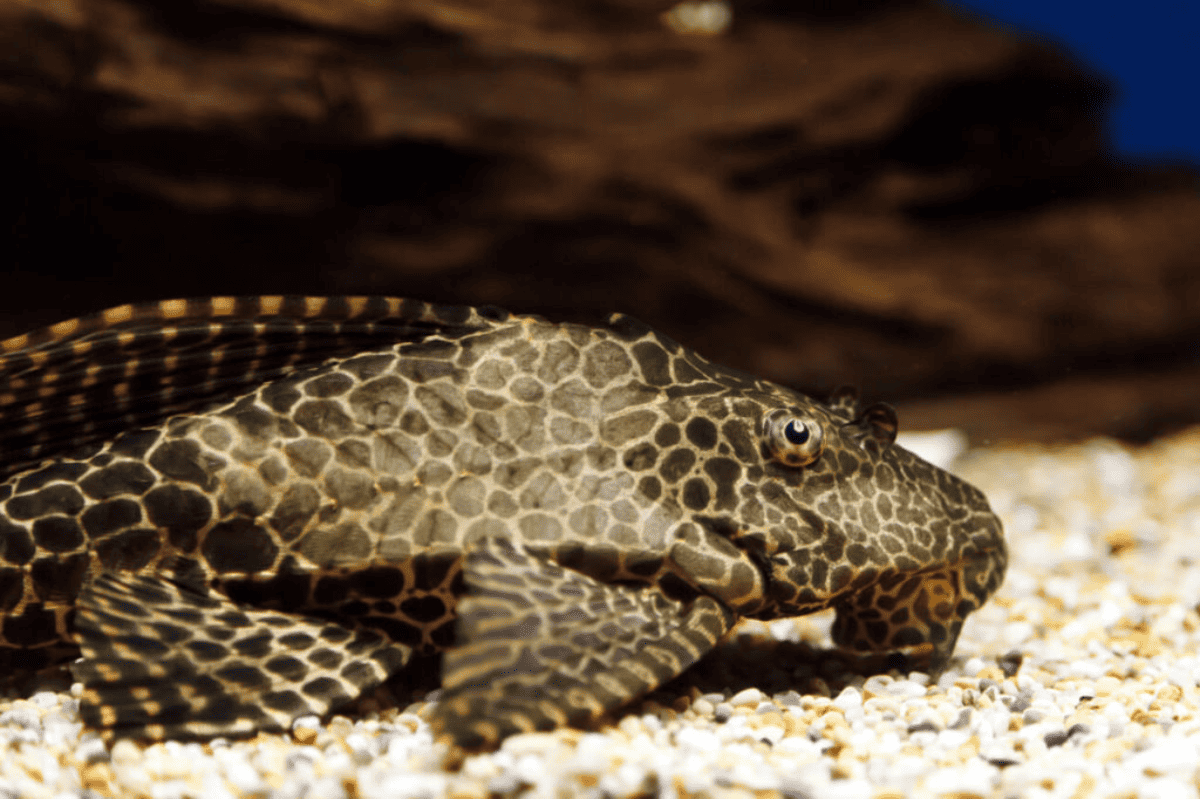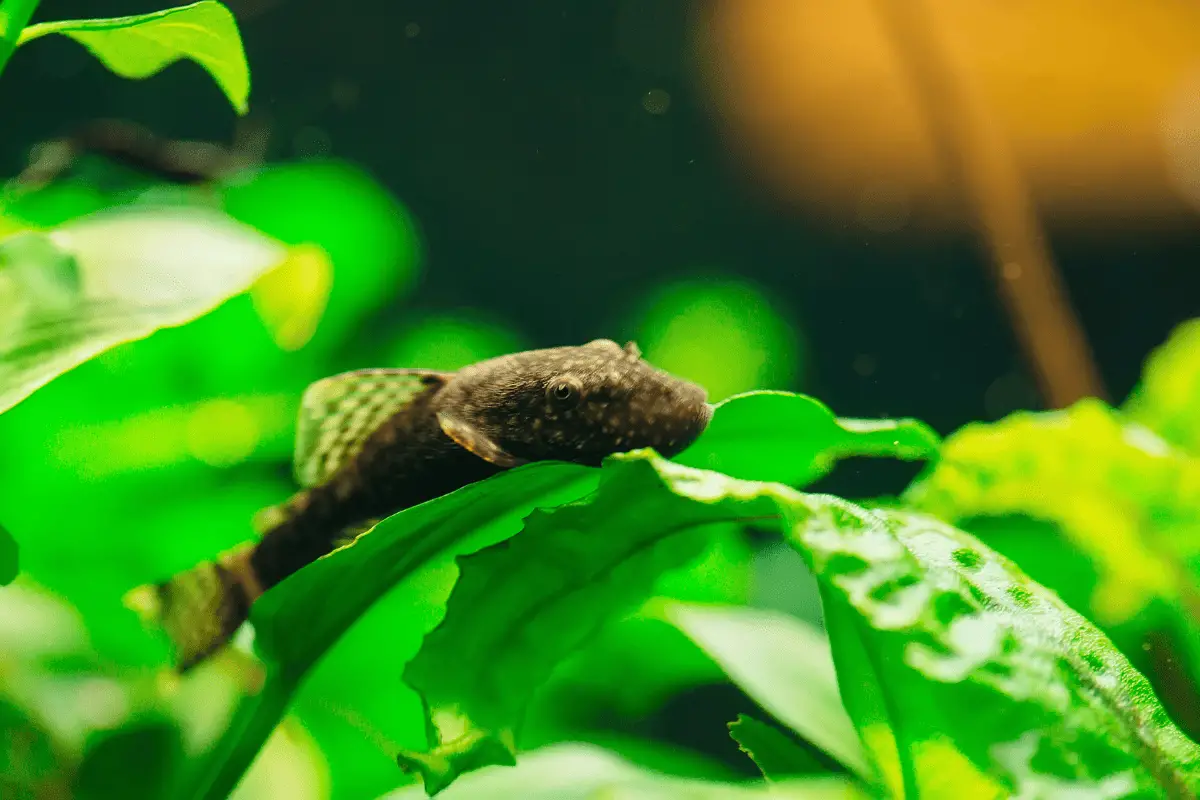It is widely known that Plecos are nocturnal creatures. They hide during the day and scavenge for food during the night.
But does it mean that Plecos can do just fine without lights? Do they need a lighting system? Can they eat at night without lights? And what if there are other fish living alongside them?
In this article, I’ll delve into all these questions and many more, so you leave with nothing hanging. Let’s get started.

Do Plecos Need Light?
No, Plecos don’t need particular lighting for their comfort. However, like most fish, they do benefit from a regular day-night cycle.
- Natural Behavior: Plecos are primarily nocturnal creatures, meaning they’re more active at night. Bright lighting can make them uncomfortable and less active during the day.
- Stress Reduction: Constant, intense light can stress Plecos out, which can lead to weaker immune systems and a higher susceptibility to diseases.
- Algae Development: Plecos, especially the standard Plecostomus, enjoy eating algae. A steady day-night rhythm fosters a balanced algae environment for Plecos to feast on.
- Tank Mates: If you keep Plecos with other fish, it’s essential to consider the lighting needs of all species. A balanced light regimen ensures all fish in the tank thrive.
- Setting A Routine: It’s beneficial for Plecos and other fish to have a consistent routine. Using a timer for your tank lights can help replicate a natural day-night cycle, supporting the well-being and regular behavior of Plecos.
Also Read: Pleco Fish Tank Setup
Creating Lighting Setup for Plecos Living with Other Fish
Here are five simple steps on how to establish a healthy lighting cycle for Plecos living with other creatures:
Step 1: Select a Dimmable Lighting System
Dimmable lighting offers versatility for aquatic environments. For Plecos, adjustable lighting means tailoring their environment for comfort.
- Flexibility: With dimmable lights, you can vary from 10% to 100% intensity, ensuring that during peak times, such as midday, it can be brighter and more subdued in the evening.
- Catering to Plecos: Given that Plecos are nocturnal, aim for 30-40% intensity during daytime hours to mimic their natural habitats like Amazon river basins.
- Energy Efficiency: LEDs, for instance, when dimmed to 50%, can save approximately 40% of energy compared to their full output.
- Longevity: Dimming lights can extend bulb lifespan by up to 50%, meaning fewer replacements over time.
My recommendation: Hygger Auto On Off LED Aquarium Light (link to Amazon).
Step 2: Maintain an 8-10 Hour Light Cycle
Consistency is key for a stable aquatic environment. Plecos, like many fish, thrive on a predictable light-dark schedule.
- Natural Rhythm: Aim to have lights on between 7 am to 5 pm to replicate a natural day cycle for the Plecos.
- Avoid Algae: Limiting light to 8-10 hours can reduce unwanted algae growth which might compete with Plecos for food.
- Automate: Use timers to ensure consistency, setting them to automatically turn on and off at specific hours.
- Seasonal Adjustment: In summer, lean towards 10 hours, and in winter, reduce to 8 hours to mimic natural light changes.
Step 3: Incorporate Caves or Driftwood for Shade
My recommendation: Dr. Moss Aquarium Malaysian Driftwood (link to Amazon).
Providing shelter is essential for Plecos, both for comfort and natural behavior expression.
- Natural Habitat: In the wild, Plecos often hide under logs or rocks; replicating this with driftwood or caves gives them a familiar environment.
- Stress Reduction: Shaded areas can reduce Plecos’ stress, as excessive light exposure can be detrimental.
- Territorial Needs: Plecos can be territorial; having multiple hiding spots ensures less conflict, especially in larger tanks.
- Tank Aesthetics: Driftwood and caves can enhance tank aesthetics, providing a more natural and pleasing look.
Also Read: Do Plecos Need Driftwood?

Step 4: Balance Lighting for All Fish Species
Every fish species has its unique lighting preference. Balancing these ensures a harmonious tank environment.
- Research Each Species: If you have other fish with Plecos, understand that they might prefer slightly brighter conditions.
- Zoning: Position brighter lights in areas where non-nocturnal fish frequent, while keeping Plecos’ areas dimmer.
- Layering: Upper swimming fish might like more light; ensure the tank’s top is brighter while the bottom, where Plecos reside, remains subdued.
- Compatibility: Always choose fish species with somewhat similar lighting requirements to Plecos to avoid significant disparities.
Step 5: Monitor and Adjust Based on Pleco Behavior
Regular observation ensures that the Plecos are comfortable and healthy.
- Activity Levels: If Plecos are too active during light hours, it may indicate discomfort; consider dimming the lights a bit.
- Physical Signs: Pale color or visible stress lines can be a sign of excessive light exposure for Plecos.
- Feeding Behavior: If Plecos aren’t coming out to feed during the dark, check if ambient light (e.g., from room lights) is too strong.
- Feedback Loop: Make adjustments based on observations and consistently check for changes in Pleco behavior to ensure their well-being.

Do Plecos Eat in the Dark?
Yes, Plecos primarily feed during the night or in low light conditions. They are nocturnal creatures by nature and prefer to forage in the darkness.
- Natural Habitats: In their wild habitats, like the Amazon river basins, Plecos are adapted to seek food under the cover of darkness to stay safe from predators.
- Safety Mechanism: Feeding in the dark allows Plecos to consume their food without competing with other, more diurnal fish species in a shared tank.
- Observation: As an aquarist, if you watch closely post-lights out, you might notice your Plecos becoming more active, scouring the tank floor and surfaces for algae and food remnants.
- Dietary Habits: Plecos eat a mix of food types. At night, they feast on algae, leftover fish food, and sometimes small aquatic animals if present.
- Tank Setup: If you have driftwood in the tank, you might see Plecos nibbling on its biofilm and algae during the calm, dark times.
Should Plecos Have Nighttime Lighting?
Plecos shouldn’t be under artificial light at night. Constant lighting can mess with their usual habits and cause them stress.
- Natural Rhythms: In their original habitats, Plecos follow the regular day-night cycle and are used to night darkness.
- Stress Indicators: Always being under light can result in noticeable stress lines in Plecos, signaling their unease and changed habitat conditions.
- Disrupted Behavior: If always lit, Plecos may become less lively, eat poorly, and might not show their usual nighttime activities, such as searching for food.
- Health Concerns: Too much light can weaken Plecos’ immune systems, increasing their disease or infection risk.
- Tank Balance: While watching Plecos at night is captivating, remember other tank dwellers also require darkness for their body clocks, maintaining a harmonious and healthy environment.

Do Plecos Need Direct Sunlight?
Plecos don’t really require direct sunlight. Although they value a regular light pattern, direct sun can create problems.
- Temperature Fluctuations: Sunlight can result in quick temperature shifts, potentially stressing Plecos. They need stable water temperatures.
- Algae Overgrowth: Direct sun boosts rapid algae formation. Even though Plecos consume algae, too much can throw off the tank’s balance.
- UV Exposure: Sunlight carries ultraviolet (UV) rays that, when too much, can harm Plecos and fellow tank mates.
- Natural Behavior: In places like the Amazon rivers, Plecos typically live in shadowed or cloudy waters, hardly ever in direct sunlight.
Do Plecos Prefer Darkness?
Yes, Plecos are quite fond of darker surroundings. As creatures of the night, they thrive and feel at ease in dim or no light.
- Natural Instinct: In nature, Plecos often take shelter under logs or in gaps during daylight, emerging to feed and wander at night.
- Safety and Comfort: The dark provides Plecos with protection from potential threats and rivals. In such conditions, they can feed and move without interruptions.
- Tank Observation: Watching your tank after sunset, you’d see Plecos becoming much more lively, displaying their nocturnal tendencies.
- Lighting Balance: While Plecos enjoy darkness, they also thrive with a regular cycle of light and dark, resembling their natural environments. Continuous dark can be as taxing as non-stop light.
- Tank Setup Tip: Offering plenty of hiding places like caverns and driftwood ensures Plecos get shaded spots during daylight, letting them experience their preferred darkness even when the tank is illuminated.
Why Is My Pleco Out During the Day?
While Plecos are naturally nocturnal, various factors can influence their behavior, prompting them to venture out during the day.
A Pleco’s daytime activity might be indicative of certain tank conditions or its well-being.
- Hunger Drive: Plecos might emerge if they’re particularly hungry. If they’re not getting enough to eat during their nocturnal hours, they may venture out during the day seeking food.
- Inadequate Hiding Spots: A tank that lacks sufficient hiding places, like caves or driftwood, can push Plecos out in the open, even during daylight.
- Tank Stressors: External stressors like aggressive tankmates, irregular water parameters, or a recent change in the tank setup might cause Plecos to alter their behavior.
- Health Issues: If your Pleco is ill or suffering from parasites, it may become more visible during the day as its behavior and habits change due to the ailment.
- Curiosity and Exploration: Sometimes, just like any creature, Plecos might simply be exploring, especially if they’re younger or newly introduced to the tank. They can occasionally deviate from their nocturnal routine out of sheer curiosity.
Also Read: Do Plecos Need A Filter?

Conclusions
For those of you who are just skimming through, here’s a short recap:
- Plecos do not require specific lighting but benefit from a regular day-night cycle to mimic their natural behavior.
- Intense lighting can stress Plecos, weaken their immune systems, and make them less active during the day.
- Establishing a dimmable lighting system with 30-40% intensity during the day can provide comfort for Plecos.
- Balancing lighting for all fish species in the tank ensures a harmonious environment and reduces stress.
- Plecos are nocturnal and prefer darkness, but a consistent light-dark cycle with hiding spots enhances their well-being in captivity.
